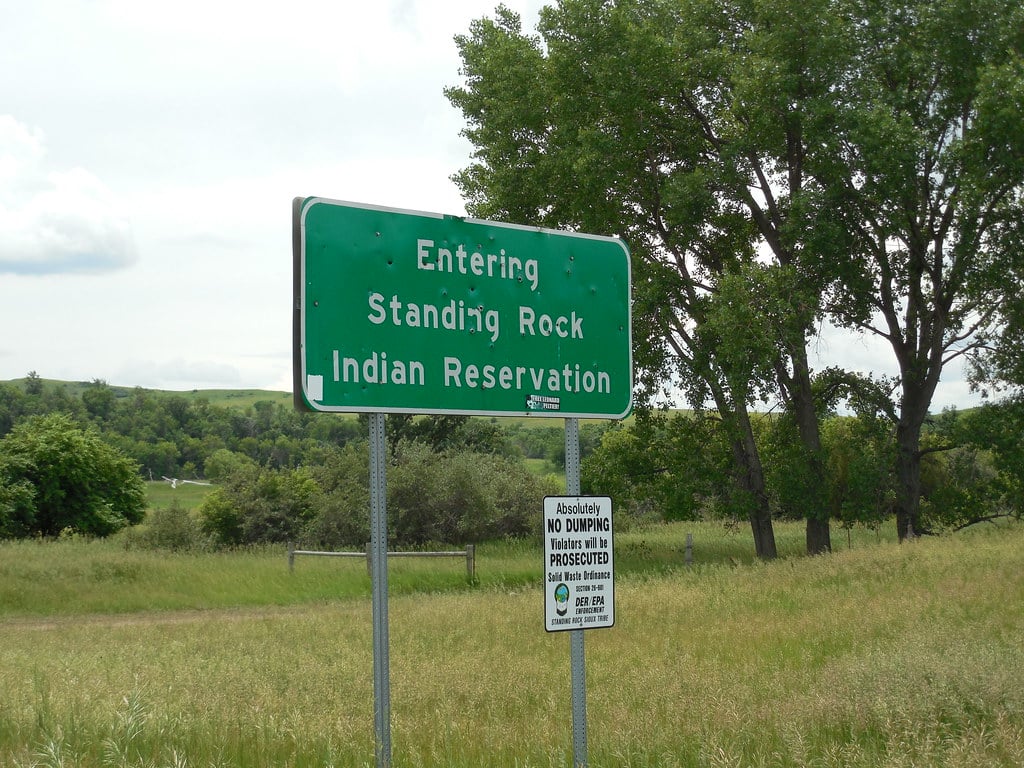
This is part five of a seven-part series produced in partnership with Grist as a companion to the SLAPP’d season of the Drilled podcast. You can see all seven pieces together in a beautiful layout over on Grist’s site, where you’ll also find other great climate stories. You can also find the rest of the stories in this series, the podcast, and related stories here.
"Here they are," explained the Gibson Dunn lawyer, Trey Cox, standing before a flat-screen television. "These are the Greenpeace six. Not a single one of them lives in this community. These people are professionals."
On the screen flashed headshots of six people, all employees of Greenpeace Inc.
“They embed in a location, then they escalate,” he said. "They thought they could do it in secret — they thought that we wouldn't be smart enough to figure out what they did."
“Today starts the day of reckoning,” he concluded.
Energy Transfer’s first witness was a towering bald man with an American flag pin on the lapel of his suit. Mike Futch was the project manager for the North Dakota section of the Dakota Access pipeline. Cox asked him about violence perpetrated by private security — like the now-infamous dog attacks.
“The only violence was when protesters came onto private property and attacked us,” Futch said. “We were always in retreat.”
According to Futch, the property damage that occurred at construction sites was intentionally violent: Pipeline opponents cut hydraulic hoses, booby-trapped equipment, filled gas tanks with sand and gravel, spray-painted cabin windows, and busted equipment gauges.
His testimony was backed up over the next few days by five law enforcement officers who agreed that the protesters were the violent ones, not security. “Violent” incidents ranged from water protectors blocking a road during a Thanksgiving Day protest in the town of Mandan, to death threats received by the now-deputy chief of the Bismarck Police Department, whose family eventually left home for a few days at the suggestion of the FBI. Captain Brian Steele testified that he got hit in the back with a big rock. Steele’s assessment: “We were probably too nice.”
It was defamation, according to Cox, for Greenpeace to say that police and private security used violence against nonviolent protesters.
On day five, Energy Transfer started playing video depositions from Greenpeace employees. On screen, Davy Khoury, a Greenpeace warehouse worker, explained how he spent hours driving on country back roads following the proposed path of the pipeline. According to his deposition, he was scouting — collecting information about what was happening with construction and passing it back to Indigenous organizers in the camps.
Energy Transfer’s lawyers displayed one of Khoury’s emails, written to another Greenpeace employee in October 2016: “The company has a place where all their toys are stored near in the Bismarck area," Khoury wrote. He suggested a protest strategy. “If the entrances were blocked, it would be very hard for them to get to the job sites."
The other Greenpeace employee responded, “I just sent 30 straight boxes down,” referring to lockboxes — plumbing pipes that protesters use to lock themselves to each other.
Greenpeace lawyers later pointed out that the protest Khoury suggested likely never happened.
In total, six Greenpeace employees visited Standing Rock during the protests — the Greenpeace Six, according to Cox — sometimes staying for a few days, sometimes for a few weeks. They all worked for Greenpeace Inc., and not the other two Greenpeace-affiliated organizations named in the suit — in fact, no one from either of the other Greenpeace groups even visited Standing Rock at all.
During their time at Standing Rock, those six employees delivered supplies, built structures, and helped the Indigenous Peoples Power Project, or IP3, train people in nonviolent direct action. In his video testimony, Nick Tilsen estimated that IP3 trained somewhere between 5,000 and 10,000 people over the course of the Standing Rock protests. Lawyers also showed that Greenpeace employees did directly participate in some protest actions; however, Tilsen stated that no one from Greenpeace led those actions, while acknowledging that his friend from Greenpeace, Cy Wagoner, helped with some planning. Rather, it was people from the area who set the agenda.
Energy Transfer alleged that Greenpeace provided funding for Standing Rock to the tune of $55,000, and that the organization's executive director at the time, Annie Leonard, helped direct a handful of foundations to donate an additional total of $90,000 to the movement.
The impact of that support, along with a defamatory information campaign, according to Gibson, Dunn, & Crutcher, was huge: Energy Transfer spent $7 million on PR firms to deal with the protests. An additional $8.5 million went toward buying the most controversial land: the ranch where Tim Mentz found the 27 burial sites and 82 stone features. The company paid contractors $14.5 million for changes to construction plans and lost another $96.4 million when Energy Transfer delayed the refinancing of loans associated with the pipeline. The pipeline was supposed to start pumping oil in January 2017 but couldn’t until June, costing the company another $80 million.
As the trial proceeded, none of the law enforcement witnesses or Energy Transfer personnel who had been on the ground seemed to know much about Greenpeace. According to public records and testimony in court, Greenpeace hardly ever appeared in the daily intelligence reports written by the private security firm TigerSwan. Of more than 1,700 pages of police operations briefings during Standing Rock, Energy Transfer’s lawyers pointed to only one that described a Greenpeace employee at a protest.
According to Sheriff Kyle Kirchmeier, up to 10,000 people were in the camps at the height of the protest. In his testimony, Kirchmeier said he believed they showed up to Standing Rock because the Standing Rock Sioux Tribe’s chairman, Dave Archambault, put out a public call and invited people to the prairie — that the real catalysts were the dog attacks, the explosion of social media coverage, and that people believed the pipeline was located on the tribe’s unceded territory.
“It’s part of the treaty,” Kirchmeier said.

Map courtesy the Museum of the American Indian teacher resource,
The tribe’s treaty is a big reason why the pipeline’s operation was delayed from January 2017 to June. The Standing Rock Sioux Tribe’s lawsuit against the Army Corps of Engineers was filed well before the camps began to grow. Under pressure from Standing Rock and other Indigenous nations, the Army Corps denied the easement that December, ordering a deeper environmental review first. In other words, for most of the months in which people protested, August 2016 to February 2017, Energy Transfer did not have permission to drill. That permission didn’t come until after Donald Trump came into office, in February 2017.
Energy Transfer and its lawyers were intimately familiar with this timeline. By November 2016, Gibson Dunn was representing the company as it attempted to push the Army Corps for permissions. And by December, the law firm had helped Energy Transfer draft a memorandum urging President Trump’s transition team to advance an executive order for the Army Corps to grant the easement.
In the end, Energy Transfer’s lobbyist in D.C. even prepared a draft of the executive order, and soon after Trump was inaugurated, he signed and issued it, directing the Army Corps to deliver an easement.
“Y'all were able to start drilling under the lake within minutes of getting that easement, right?” a Greenpeace lawyer asked Energy Transfer’s board president Kelcy Warren during a video deposition.
“Shortly thereafter, yes sir,” said Warren with a laugh.
The Standing Rock Sioux Tribe does play a major role in the true story of Energy Transfer's Dakota Access pipeline easement. In the months after the pipeline was installed under the river, the Standing Rock Sioux Tribe and other Indigenous nations continued pushing for a federal court to shut the pipeline down. In June 2017, a judge ruled that the Army Corps would have to redo parts of its environmental review. The legal back-and-forth dragged on for years.
Energy Transfer’s banks took note. In court, Energy Transfer alleged that Greenpeace’s divestment campaign, and its defamatory lies, forced the company to delay refinancing a loan, which cost them $96.4. However, meeting minutes from Energy Transfer’s board of directors, described in court, indicate that the company actually decided to hold off on refinancing due to banks’ concerns about the Standing Rock Sioux Tribe’s ongoing legal battle — not Greenpeace.
“This is all a bunch of bullshit,” said Doug Crow Ghost, the tribe’s head of water resources, of the Greenpeace lawsuit. Crow Ghost noted that the tribe took in $11.7 million in donations related to the pipeline protests. Greenpeace’s $55,000 and $90,000 in foundation funding was meager by comparison.
But no Standing Rock member testified in the Greenpeace trial. As a rule, the Standing Rock Sioux Tribe doesn’t go to state court: The state has no jurisdiction over the nation due to federal Indian law.
You’ll find the rest of the stories in this series, as well as the podcast and related stories here.






